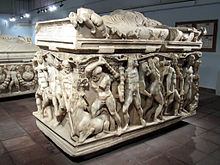|
Tiberiopolis
Tiberiopolis (Ancient Greek: Τιβεριούπολις; sometimes in sources, Tiberiapolis, and Pappa-Tiberiopolis; formerly Pappa)[1][2] was a town in the Roman province of Phrygia Pacatiana, mentioned by Ptolemy,[3] Socrates of Constantinople[4] and Hierocles.[5] At various times, it was considered as part of Phrygia, Isauria, and the late Roman province of Pisidia.[6] It struck its own coins at least from the time of Trajan.  It was situated at the modern village of Yunuslar, Beyşehir district, in Konya Province, Turkey.[2] At Tiberiopolis the famous Roman sarcophagus showing the Twelve Labours of Hercules now displayed at the Konya Archaeological Museum was recovered.[2] It must have been Christianised at an early date. Nicephorus, a presbyter at Tiberiopolis was martyred in 361 or 362, and later canonized.[7] His feast is celebrated on 28 November.[7] BishopricTiberiopolisThe bishopric of Tiberiopolis appears in the oldest Greek Notitiae episcopatuum among the suffragans of Laodicea in Phrygia, capital and metropolitan see of the late Roman province of Phrygia Pacatiana, but in the 8th century it was attached to Hierapolis in Phrygia, capital and metropolitan see of Phrygia Pacatiana Secunda, and as such appears in the Notitiae episcopatuum of the Ecumenical Patriarchate of Constantinople until the 13th century, when the area was overrun by the Seljuk Turks. BishopsLe Quien[8] mentions five of its bishops known by their presence at councils:
Roman Catholic titular seeTiberiopolis remains a titular see in the Roman Catholic Church.[9] Titular bishops have been:[9]
PappaUnder the name of Pappa, the town was also a bishopric of the province of Pisidia, and later a titular see of the Roman Catholic Church.[10] Notes
References
|
||||
